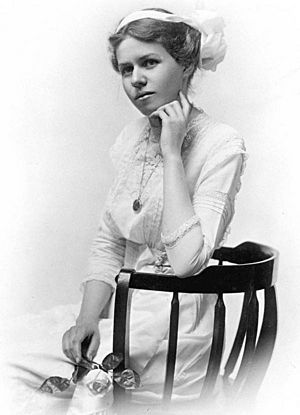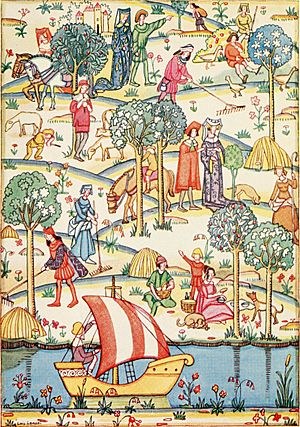Lois Lenski facts for kids
Quick facts for kids
Lois Lenski
|
|
|---|---|
 |
|
| Born | Lois Lenski October 14, 1893 Springfield, Ohio, United States |
| Died | September 11, 1974 (aged 80) Tarpon Springs, Florida |
| Occupation | Writer, illustrator |
| Education | Ohio State University, Art Students League of New York, Westminster School of Art |
| Period | 1920–1974 |
| Genre | Children's novels, picture books |
| Notable awards | Newbery Medal 1946 Strawberry Girl |
Lois Lenski (born October 14, 1893 – died September 11, 1974) was a famous American author and illustrator. She won the prestigious Newbery Medal for her children's books. Lois Lenski wrote and drew pictures for nearly 100 books during her career.
Her first books, Skipping Village and Jack Horner's Pie: A Book of Nursery Rhymes, came out in 1927. She created many types of books, including picture books, chapter books, songbooks, and poetry. She even wrote her own life story, called Journey into Childhood, in 1972.
Some of her most well-known works include the "Mr. Small" picture book series. She also wrote "Historical" novels, like Phebe Fairchild: Her Book and Indian Captive: The Story of Mary Jemison, which won Newbery Honor awards. Her "Regional" series, which showed life in different parts of America, included the Newbery Medal winner Strawberry Girl and Judy's Journey.
Lois Lenski also drew pictures for books by other authors. She illustrated the first edition of The Little Engine That Could and the first four books in Maud Hart Lovelace's Betsy-Tacy series. In 1967, she started the Lois Lenski Covey Foundation. This foundation helps libraries buy books for children who might not have many books at home.
Contents
Lois Lenski's Life Story
Her Early Years and School
Lois Lenski was the fourth of five children. Her father, Richard C. H. Lenski, was a Lutheran pastor and theologian from Prussia. Her mother, Marietta Young Lenski, was a schoolteacher from Ohio. When Lois was six, her family moved to a small town called Anna, Ohio.
From a young age, Lois showed a talent for art. Teachers and even a visiting artist encouraged her. Her father bought her good quality paints. She remembered that until she was about 15, she mostly copied other pictures. No one told her to draw what she saw around her.
Lois went to high school in Sidney, Ohio, graduating in 1911. She then attended Ohio State University, where she studied education and fine arts. She graduated in 1915. After Ohio State, she received a scholarship to the Art Students League in New York City. She studied there until 1920. She also studied illustration at the School of Industrial Art in New York. In 1920, Lois traveled to London to study at the Westminster School of Art. After that, she spent several months traveling in Italy before returning home.
Marriage and Family Life
In 1921, Lois Lenski married Arthur Covey. He was a muralist and had been one of her teachers. Arthur already had two young children. In 1929, Lois and Arthur had a son named Stephen. The family then moved to an old farmhouse called "Greenacres" in Harwinton, Connecticut. The house was built in 1790.
Lois was very dedicated to her writing and art. Even with family duties, she found time to work in her studio. She later wrote that her husband's attitude helped her realize how important her work was to her.
How Her Family Inspired Her Books
Lois Lenski's family and home life greatly inspired her stories. Her first books, Skipping Village (1927) and A Little Girl of 1900 (1928), were about her own childhood in small-town Ohio. She remembered it as "simple, sincere, and wholesome."
The "Mr. Small" series of books came from watching her son Stephen play. She noticed that children imagined themselves as the drivers of toy trucks and planes. This gave her the idea for Mr. Small, who operates different vehicles. Later, she based two other picture book series, the "Davy" and "Debbie" books, on her experiences with her grandson and granddaughter.
Her first historical novel, Phebe Fairchild: Her Book, was inspired by living at Greenacres. It described what life might have been like in that house in the 1830s.
In the early 1940s, Lois Lenski's doctor told her to avoid Connecticut's cold winters for her health. So, the family started spending winters in the southern United States, first in Louisiana and then in Florida. During these trips, Lois saw how different life was in the South compared to the Midwest and Northeast. This inspired her to write about the lives of children in various American regions. She continued writing these "Regional" stories until 1968.
Later Life and Achievements
In 1951, Lois Lenski and her husband built a house in Tarpon Springs, Florida. They spent half of each year there. After her husband's death in 1960, Lois moved to Florida permanently. She kept writing, publishing her last picture book, Debbie and her Pets, in 1971. Her autobiography came out in 1972.
In 1967, she started the Lois Lenski Covey Foundation. Lois Lenski received many awards and honors for her work. She earned honorary doctorates from several universities. She also won the Regina Medal and the Children's Collection Medal. Lois Lenski passed away on September 11, 1974, at her home in Tarpon Springs.
Her Early Art and Writing Career
Lois Lenski first wanted to be a painter. Her oil paintings were shown in a New York gallery in 1927. Her watercolors were also shown in 1932. She also worked as an illustrator to support herself while studying art. Her first published work was a coloring book called A Children's Frieze Book in 1918. She also created three paper doll books.
In 1920, Lois chose to study in London because it was a major center for children's book publishing. In London, she illustrated three children's books for the publisher John Lane. These included new editions of stories by Kenneth Grahame, who wrote The Wind in the Willows. After returning to the United States, she continued illustrating, often for collections of folktales and fairy tales. She also started writing her own stories, including a collection of nursery rhymes.
In 1927, a children's book editor named Helen Dean Fish suggested that Lois should try writing her own stories. Her first book, Skipping Village, was originally poetry. She changed it to prose at her editor's request. Years later, she would return to writing poetry and song lyrics. In 1932, Lois Lenski published The Little Family. This was a special picture book because it was the first of its kind sized to fit small children's hands.
Until the mid-1940s, Lois Lenski continued to illustrate books for other authors. These included Maud Hart Lovelace and Watty Piper.
How Lois Lenski Wrote Her Books
Lois Lenski wanted her books to show the world as accurately as possible. She saw herself as an observer who would learn about different places and share what she saw with others. This was a common idea in American art and writing during the Great Depression.
She often wrote dialogue in a way that showed how people really spoke in different regions. She believed that to truly capture a place, you couldn't change how people talked into "perfect" school English. She also made sure to include sad or difficult parts of life in her stories. She felt that "life is not all happy" and that her young readers agreed. She showed the tough parts of life, like poverty or violence, that she had seen or learned about. When she accepted the Newbery Award for Strawberry Girl, she said that leaving out these things would "paint a false picture."
Beyond just showing accurate pictures of communities, Lois Lenski wanted her books to teach important lessons. She wanted to promote tolerance, acceptance of differences, and respect for others. She believed that when we understand how other people live, we see them as "human beings like ourselves."
She also wanted her books to help children feel empathy. She hoped that through her characters' experiences, children would learn and grow emotionally. She wrote that she wanted to show children that "all people are flesh and blood and have feelings like themselves." She aimed to show that good, strong people often come from simple backgrounds and deserve our admiration.
Selected Books by Lois Lenski
- Picture Book Series
- Mr. Small books (1934-1962)
- Davy books (1941-1961)
- Debbie books (1967–71)
- Seasons books (1945–53)
- Historical Series
- Phebe Fairchild, Her Book (1936, Newbery Honor book)
- A-Going to the Westward (1937)
- Bound Girl of Cobble Hill (1938)
- Ocean-Born Mary (1939)
- Blueberry Corners (1940)
- Indian Captive: The Story of Mary Jemison (1941, Newbery Honor book)
- Puritan Adventure (1944)
- Roundabout America Series
- We Live in the South (1952)
- Peanuts for Billy Ben (1952)
- We Live in the City (1954)
- Project Boy (1954)
- Berries in the Scoop (1956)
- We Live by the River (1956)
- Little Sioux Girl (1958)
- We Live in the Country (1960)
- We Live in the Southwest (1962)
- We Live in the North(1965)
- High-Rise Secret (1966)
- Regional Series
- Bayou Suzette (1943, Ohioana Book Award winner)
- Strawberry Girl (1945, Newbery Award winner)
- Blue Ridge Billy (1946)
- Judy's Journey (1947, Children's Book Award winner)
- Boom Town Boy (1948)
- Cotton in My Sack (1949)
- Texas Tomboy (1950)
- Prairie School (1951)
- Mama Hattie's Girl (1953)
- Corn-Farm Boy (1954)
- San Francisco Boy (1955)
- Flood Friday (1956)
- Houseboat Girl (1957)
- Coal Camp Girl (1959)
- Shoo-Fly Girl (1963)
- To Be a Logger (1967)
- Deer Valley Girl (1968)


